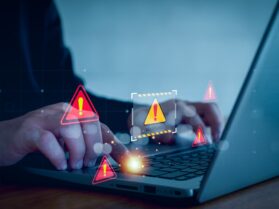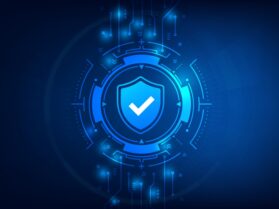It is the 21st century where data and digital assets are the key players. This stands as the bright side of all. However, security is a concern that cannot be overlooked. As we delve into 2024, cybersecurity is emerging as never life before. The rise in cyberattacks and cybercriminals is a crucial point of discussion. Cybercriminals are becoming increasingly sophisticated, leveraging advanced technologies and exploiting vulnerabilities in digital systems.
To find an ideal way through the digital realm effectively. It is crucial to have the complete cybersecurity scenario, as in the cybersecurity trends, threats, and best practices that can help individuals and organizations secure their online presence. In this context, we’ll get through the same. Without any further ado, let's get started.
The Overview of Cybersecurity in 2024
As we enter 2024, it is essential to keep a close track of the current state of cybersecurity. This section provides insights into the existing challenges and emerging trends in the cybersecurity journey that will help to keep you informed and updated.
Challenges in Cybersecurity:
- Ransomware Proliferation: Ransomware attacks have grown immensely and causing significant operational damage and leading to financial losses to companies. Cybercriminals are continually finding new ways to exploit this tactic, making it a persistent threat.
- AI-Powered Attacks: The use of AI in cyberattacks is on the surge. AI has the potential to generate bulk phishing emails and malware that can adapt to security measures making it challenging to detect and mitigate threats.
- Supply Chain Vulnerabilities: Supply chain attacks are becoming more common as businesses rely on an intricate network of suppliers and partners. Identifying and securing the supply chain is crucial to prevent breaches.
- Deepfakes and Disinformation: Deepfakes, AI-generated synthetic media, pose a threat to information security. They can be used to deceive, manipulate, and spread disinformation.
- Cloud Vulnerabilities: As organizations migrate to the cloud, it becomes an attractive target for cybercriminals. Unauthorized access to cloud infrastructure and data breaches are a point of concern.
- Insider Threats: Employees with access to sensitive information may inadvertently or intentionally compromise security.
- IoT and 5G Challenges: The widespread adoption of 5G technology and the widespread Internet of Things (IoT) devices create new opportunities for cybercriminals to exploit vulnerabilities in interconnected devices and critical infrastructure.
Emerging Trends in Cybersecurity
Amidst the challenges, there are several trends shaping the future of cybersecurity:
- Ransomware-as-a-Service (RaaS): The evolution of RaaS platforms is expected to make ransomware attacks even more common. Organizations need to boost their security strategies to fight back against this growing threat.
- AI and Automation: AI is being harnessed both for defense and offense in the cybersecurity realm. It is paramount to understand the role of AI in cyberattacks.
- Supply Chain Security: Strengthening supply chain security through risk assessments and access controls is the main focus for organizations.
- Deepfake Detection: The necessity for effective deepfake detection tools and strategies is becoming important to combat disinformation.
- Cloud Security: As data migration to the cloud continues, comprehensive cloud security measures are vital to protect sensitive information.
- User Education: Educating users and creating awareness about cybersecurity best practices is a very trend.
- Multi-Factor Authentication (MFA): The adoption of MFA as an additional layer of security continues to come to light, offering enhanced protection for user accounts.
- Cyber Insurance: Businesses are investing heavily in cyber insurance to mitigate financial losses in the event of cyberattacks.
Ransomware-as-a-Service (RaaS): The Rising Threat
Knowing Ransomware and Ransomware-as-a-Service
Ransomware has become a common threat in recent years, with cybercriminals, encrypting data and demanding a ransom for release. These platforms offer malicious actors with tools and infrastructure to carry out ransomware attacks efficiently. The proliferation of RaaS underscores the importance of proactive cybersecurity measures for defending against this evolving threat.
Strategies to Defend Against Ransomware and RaaS
Defending against ransomware and RaaS requires a multi-faceted approach:
- Regular Backups: Maintaining regular and encrypted backups of critical data. In the event of a ransomware attack, having clean backups can help to save your organization from paying ransoms.
- Security Awareness: Educating employees about the risks of phishing emails and suspicious attachments, which are the center points for ransomware.
- Patch and Update: Keeping all software and systems up to date to patch known vulnerabilities that ransomware exploits.
- Implement Endpoint Protection: Use robust endpoint protection software that can easily detect and mitigate the attacks.
- Network Segmentation: Isolate sensitive data and critical systems from the rest of the network to limit the spread of ransomware.
- Ransomware Response Plan: Develop and test a ransomware response plan that outlines steps to take in the event of an attack.
- Cyber Insurance: Consider investing in cyber insurance to mitigate the financial impact of a ransomware attack.
Make sure a proactive approach is the best defense against ransomware and RaaS.
AI-Powered Attacks: Guiding Through the AI Frontier

The Role of AI in Cybersecurity
Artificial Intelligence (AI) is a very powerful tool that has found applications in various domains, including cybersecurity. However, cybercriminals are also using the power of AI to develop more sophisticated attacks. Here are the strategies to overcome them.
Strategies to Combat AI-Powered Attacks
As AI-powered attacks become more sophisticated, organizations need to adapt their cybersecurity strategies accordingly:
- Behavior-Based Detection: Implement AI-driven behavior-based detection systems that identify anomalies and threats based on behavioral patterns.
- Advanced Email Filtering: Utilize advanced email filtering solutions to detect and block phishing attempts, even if they use AI-generated content.
- Adaptive Security Measures: Implement security solutions that can adapt to changing attack patterns.
- Employee Training: Continuously train employees about the smart tactics of cybercriminals and the importance of vigilance in recognizing and reporting potential threats.
- Regular Software Updates: Keep security software and systems up to date to benefit from the latest AI-driven threat detection capabilities.
Adopting AI-driven defenses is a good approach to staying ahead of AI-powered attacks. AI can be an asset in the battle against cyber threats when used for crucial purposes.
Supply Chain Attacks: Safeguarding Against Vulnerabilities
Understanding Supply Chain Attacks
Supply chain attacks are growing at a rapid pace and are a concern for organizations. These attacks target an organization's extended network, making it critical to assess the security posture of partners and implement strong access controls.
Strategies to Boost Supply Chain Security
Securing your supply chain is vital to protect against this emerging threat:
- Vendor Risk Assessments: Regularly assess the security practices of third-party vendors and service providers. Make sure they meet your organization's security standards.
- Access Control: Implement stringent access controls to limit third-party access to your systems and data. Provide limited necessary access.
- Continuous Monitoring: Monitor third-party activities within your network to detect any suspicious behavior.
- Incident Response Plan: Develop a robust incident response plan that gives the steps to take in case of a supply chain breach.
- Data Encryption: Encrypt sensitive data shared with third-party vendors to mitigate the impact of a breach.
- Data Resilience: Make sure that the critical data and operations are resilient and can counter the supply chain attacks.
By focusing on supply chain security, organizations can fortify their defenses against this increasingly common threat.
The Core Practise of Deepfakes and Disinformation: Securing Information Integrity
The Threat of Deepfakes and Disinformation
Deepfakes or AI-generated media are becoming a big concern due to the spread of disinformation and deceive the public. Attackers are largely using the potential of deepfakes for malicious purposes such as influencing public opinion, spear phishing and more. Here are some of the best strategies for detecting and countering deepfakes.
Strategies to Detect and Counter Deepfakes
Detecting and countering deep fakes and disinformation requires a multi-pronged approach:
- Deepfake Detection Tools: Invest in deepfake detection tools and software for identifying altered media content.
- Verification Protocols: Implement stringent verification protocols for video and audio content, especially in high-stakes situations.
- Educate Employees: Educate employees about the risks of deepfakes and the importance of verifying information before acting.
- Media Authenticity Checks: Conduct authenticity checks for media content, especially when it involves financial transactions or critical decisions.
- Content Source Verification: Carefully verify the source of media content to ensure that it's from a trustworthy or reputable origin.
By being proactive in detecting and countering deepfakes, organizations can protect their reputation and integrity.
Cloud Jacking: Securing Cloud Infrastructure
The Demand for Cloud Jacking for Cybercriminals
As most of organizations are shifting their data to cloud infrastructure, it is becoming a targeted home for cybercriminals. Cloud jacking is about gaining unauthorized access to a company’s cloud infrastructure to gain or promote further attacks.
Strategies to Defend Against Cloud Jacking
It is important to secure your cloud infrastructure to prevent data breaches and unauthorized access:
- Identity and Access Management (IAM): Implement IAM controls to control and monitor the access of your cloud resources.
- Data Encryption: Encrypt sensitive data that’s stored in the cloud, thereby protecting it from unauthorized access.
- Regular Security Audits: Perform regular security audits and penetration testing to find out vulnerabilities in your cloud environment.
- Multi-Factor Authentication (MFA): Require MFA for access to your cloud resources to improve security.
- Incident Response Plan: Develop a robust incident response plan specifically for cloud security incidents.
- Security as a Service: Consider using cloud security services that offer additional layers of protection.
By taking the steps mentioned above, organizations can enhance their cloud security and protect unauthorized access to their crucial data and resources.
Insider Threats: The Unceasing Challenge
The Major Concern of Insider Threats
Insider threats have been a long-time challenge for organizations. After the Covid pandemic as remote work became the new normal, detecting and defending against insider threats has become more complex. Employees having access to sensitive information may be a risk to the organization’s security.
Strategies to Mitigate Insider Threats
Mitigating insider threats requires a combination of technical measures and employee awareness:
- User Activity Monitoring: Strategically implement user activity monitoring for detecting suspicious behavior mainly in the case of remote work.
- Data Loss Prevention (DLP): Use different types of DLP tools to prevent unauthorized access or sharing of sensitive information.
- Regular Employee Training: Educate employees to recognize and respond to potential threats quickly.
- Access Controls: Restrict access controls to limit employee access to sensitive data and systems.
- Privileged Access Management (PAM): Use PAM solutions for controlling and monitoring access to critical systems.
- Incident Response Plan: Develop a proper incident response plan incident response plan that aligns with insider threats.
In a nutshell, by prioritizing internal network monitoring and training employees properly, organizations can reduce the risk of insider threats and detect them as soon as they occur.
5G and IoT Security Challenges: Protecting the Inter-Connected World

The Emerging and Growing Landscape of IoT and 5G
5G technology is now ruling the internet world. It is increasing the number of connected devices, thus making IoT a part of our daily lives. While the convenience and efficiency of IoT devices are undeniable, they are a new edge for cybercriminals.
Ways to Secure IoT and 5G Networks
To keep away from the vulnerabilities of IoT devices, organizations can leverage the steps given below:
- Network Monitoring: Monitor IoT networks for anomalies and unusual activities continuously.
- Security by Design: Consider security in the design and deployment of IoT devices and networks, rather than as a second thought.
- Incident Response for IoT Devices: Develop a specific incident response plan for IoT security incidents.
- Regulatory Compliance: Stay compliant with industry-specific regulations regarding IoT security.
- Segment IoT Networks: Isolating IoT networks from critical infrastructure to limit the potential impact of data breaches.
- Regular Device Updates: Ensuring that IoT devices are updated regularly with firmware updates and security patches.
- Strong Authentication: Implementing robust authentication mechanisms for IoT devices to restrict unauthorized access.
By focusing on IoT security, organizations can benefit from the convenience of connected devices while minimizing the associated risks.
Cyber Threat Intelligence: Staying Informed and Proactive
The Role of Threat Intelligence in Cybersecurity
Cyber threat intelligence is the process of analyzing existing threats and identifying potential risks in the future. In the ever-changing cybersecurity landscape, threat intelligence plays a pivotal role in staying informed and proactive.
Strategies for Implementing Cyber Threat Intelligence
To effectively leverage threat intelligence, organizations can implement the following strategies:
- Continuous Monitoring: Establish continuous monitoring of threat intelligence sources to keep track of emerging threats.
- Information Sharing: Connect with other organizations and share threat intelligence to create a collective defense against cyber threats.
- Vulnerability Assessments: Asses your organization's vulnerabilities regularly and align your defense strategy accordingly.
- Incident Response: Develop and test incident response plans that include threat intelligence to reduce the impact of threats.
- Security Training: Make sure that your IT or security team is highly trained and can act upon any of the security incidents promptly.
By incorporating threat intelligence into your cybersecurity strategy, you can anticipate and mitigate emerging threats effectively.
Cloud Security: Securing Data in the Cloud-First World
The Importance of Cloud Security
Cloud computing is a buzzing topic and has become a crucial part of the business world. The advantage it offers is wholesome. However, it also comes with cybersecurity risks that can lead to losses. Cloud security is of utmost importance due to the increase in remote work, mobile trends, etc. As businesses are migrating tons and tons of data to the cloud, a best-in-class cloud strategy is essential to keep your data safe and avoid breaches.
Strategies for Enhancing Cloud Security
Here are some of the best cloud security strategies, organizations can adopt to keep hackers at bay and stay safe in the digital world.
- Identity and Access Management (IAM): Implementing robust IAM controls for monitoring and controlling access to cloud resources.
- Data Encryption: Encryption of sensitive data in the cloud to protect it from gaining unauthorized access.
- Compliance and Auditing: Follow the industry-specific regulations and conduct regular security checks and audits of your cloud environment.
- Multi-Factor Authentication (MFA): Add an extra layer of protection by adding an MFA for accessing the cloud resources.
- Continuous Monitoring: Keep a close eye on the threats and malicious activities of your cloud environment.
- Incident Response Plan: Create a strong incident response plan specific to cloud security.
Cloud Service Provider (CSP) Security:

Cloud Service Provider (CSP) Security: Closely understand the security measures provided by your CSP and make sure they align with your organization's requirements adeptly. By implementing these cloud security measures, organizations can utilize the benefits of cloud computing while safeguarding their data.
Cyber-Insurance: A New Horizon in Risk Management
Explaining the Role of Cyber-Insurance in Risk Mitigation
Cyber insurance is the latest addition in the era of cybersecurity and risk management. This type of insurance offers financial support in case of financial losses due to cyberattacks. Cyber insurance provisions include protections from different kinds of threats including, data breaches, cyber extortion, employee error and more.
Effective Strategies for Utilizing Cyber-Insurance
Cyber insurance is becoming a vital tool for any SMB or a large-scale business with an online presence, providing financial security in the event of a cyber incident.
Organizations can consider opting for the below strategies to leverage cyber-insurance successfully.
- Assessment and Coverage Selection: Evaluate your organization's specific cybersecurity risks and select a cyber insurance policy that aligns with your needs.
- Data Security Policies: Develop and implement data security policies and practices that may be required by the insurance provider.
- Incident Response Planning: Ensure that your incident response plan includes provisions for coordinating with your insurance provider in the event of a cyber incident.
- Regular Review: Continuously review and update your cyber insurance policy to reflect changes in your organization's risk profile.
- Education and Training: Train employees to understand the role of cyber insurance in risk management and how to report incidents to facilitate claims.
AI and Automation in Cybersecurity
The Principal Role of AI and Automation in Cybersecurity
The growth of Artificial Intelligence (AI) and automation in cybersecurity has made managing security more efficient and manageable. However, hackers are also harnessing AI to infiltrate vulnerable networks.
- Strategies for Utilizing AI and Automation in Cybersecurity: To use AI and automation for cybersecurity, organizations can start embracing the following strategies:
- AI-Driven Threat Detection: Implementing AI-driven threat detection systems that can firmly identify threats and respond to threats immediately. Using automation to streamline and harmonize with the security responses. Plus, it reduces the security response time.
- Educating Employees: Provide proper training to employees on how to use AI and automation in cybersecurity effectively.
- AI in Data Analytics: Use the power of AI in data analytics to identify patterns and anomalies that designate a security breach. Monitoring AI-driven security constantly to ensure their effective functioning.
By incorporating the above AI and automation strategies, organizations can level up their cybersecurity game and defend against attacks efficaciously.
The Internet of Things (IoT): A Booming Attack Surface
The Growing Significance of IoT Security
The Internet of Things (IoT) refers to the connection of physical devices and objects within the digital world. It encompasses wearable tech, medical devices, home appliances, and more. As IoT devices lack traditional security infrastructure, they are vulnerable to cyberattacks.
Top Strategies for Securing IoT Devices and Networks
Organizations can use the strategies for the effective security of IoT devices and networks.
- Segmentation: The process of isolating IoT networks from critical infrastructure to limit the impact of data breaches.
- Firmware Updates: Ensure that IoT devices regularly receive security patches and firmware updates.
- Authentication and Encryption: Implementing strong authentication methods and data encryption for IoT devices.
- Incident Response: Create a proper plan and be prepared for any of the disasters or security incidents.
- Security by Design: Consider security from the outset when designing and deploying IoT devices and networks.
By focusing on the above IoT security, organizations can unleash the full benefits of connected devices while minimizing the risks.
Multi-Factor Authentication (MFA): A Critical Security Layer
The Significance of Multi-Factor Authentication (MFA)
Multi-factor authentication (MFA) is an important security method that boosts security by requiring users to offer multiple pieces of information to authenticate their identity. It works by adding an extra layer of security and is a principal element in securing user accounts.
Robust Strategies for Implementing MFA
Below are some of the proven strategies that organizations can incorporate to implement MFA and take security to the next level.
- MFA for Individuals: During the login process, the user needs to provide two or more factors for the authentication and login process.
- Biometric Authentication: Integrate biometric authentication methods, such as facial recognition or fingerprints.
- Single Sign-On (SSO) Integration: Combining MFA with Single Sign-On (SSO) solutions to simplify identity management while enhancing security.
- Educate Users: Train users on how to use the MFA to its full potential.
The Future of Cybersecurity in 2024
How Does the Cybersecurity Future Look in 2024?
As we enter 2024, the cybersecurity landscape is a two-way sword. It promises both a range of opportunities as well as challenges. Below are the trends that will be ruling the cybersecurity world in 2024.
- Enhanced Automation & AI: Automation and AI are the game changers and will play a crucial role in the cybersecurity subject.
- Machine Learning: ML will become a foundation of cybersecurity, allowing systems to adapt to rising threats.
- Improved Collaboration & Cyber Security Analytics: An effective collaboration between organizations and enhancements of analytics will steer toward productive cybersecurity measures.
- Cloud Security: Priority: With organizations largely adopting cloud services, there will be maximum focus on cloud security solutions.
- Emphasis on Education & Awareness: Increased user awareness and educating them about cybersecurity best practices will generally take center stage.
In conclusion, mastering cybersecurity in 2023 and beyond requires a proactive approach, continuous learning, and staying informed about emerging threats and trends. By implementing robust security measures, leveraging the power of AI and automation, securing the IoT, and investing in cyber insurance, organizations and individuals can navigate the ever-evolving cybersecurity landscape with confidence. Remember, the key to a secure digital future lies in constant vigilance and proactive defense against emerging cyber threats.
As we venture into 2024, the future of cybersecurity holds exciting possibilities and new challenges. The increased integration of automation, artificial intelligence, and machine learning promises more efficient and adaptive security measures. Collaboration and improved analytics will lead to a stronger defense against cyber threats. Furthermore, a greater focus on user education and awareness will empower individuals to play a crucial role in enhancing cybersecurity.
Conclusion
In the fast-paced world of cybersecurity, staying ahead of the curve is essential to protect your digital assets. The challenges and trends in cybersecurity for 2023 present both opportunities and threats. By understanding these dynamics and implementing the recommended strategies, you can navigate the evolving landscape with confidence. Let's conclude our exploration of cybersecurity in 2023 with a recap of key takeaways and a look ahead to what the future may hold.
Remember that staying vigilant, regularly updating your security strategies, and adapting to emerging threats are essential practices in the dynamic world of cybersecurity. By embracing these principles, you can continue to master cybersecurity and safeguard your digital assets effectively. In conclusion, mastering cybersecurity in 2023 and beyond demands proactive defense and continuous learning. By understanding the challenges and trends outlined in this comprehensive guide, you are better equipped to navigate the ever-evolving cybersecurity landscape and protect your digital presence effectively.
Key Takeaways
Here are the key takeaways from the blog:
- AI-Powered Attacks: AI-driven threats that need behavior-based detection, staff training and advanced email filtering.
- Supply Chain Security: To safeguard against supply chain attacks, carry out risk assessment, conduct vendor, implement access control and create a strong incident response plan.
- Deepfakes and Disinformation: Prevent your organization from deepfakes by using verification tools, detection tools and more.
- Cloud Security: Enhance the security of your cloud environment through data encryption, compliance and continuous monitoring.
- Insider Threats: Reduce insider threats with the help of restricting access, activity monitoring and employee training.
- 5G and IoT Security: Secure the 5G networks and IoT with regular updates, strong authentication methods, segmentation and incident response planning.
- Cyber-Insurance: Consider cyber insurance to reduce financial losses in case of cyber-attacks and align your policy well with your organization's specific risks.
- AI and Automation: Usage of AI and automation for detecting threats, security orchestration and outperforming your security measures.
- The Internet of Things (IoT): Rightly security networks and IOT devices using different methods like, firmware updates, authentication, segmentation and continuous monitoring.
- Multi-Factor Authentication (MFA): Strengthen account security with MFA, including biometric authentication and user training.
- Ransomware-as-a-Service (RaaS): Ransomware attacks and the emergence of RaaS platforms, require taking proactive measures such as security awareness, regular backups and robust endpoint protection.
- Cyber Threat Intelligence: Leverage threat intelligence to stay in the know, conduct vulnerability assessments, share information and improve your incident response.
Read More:





